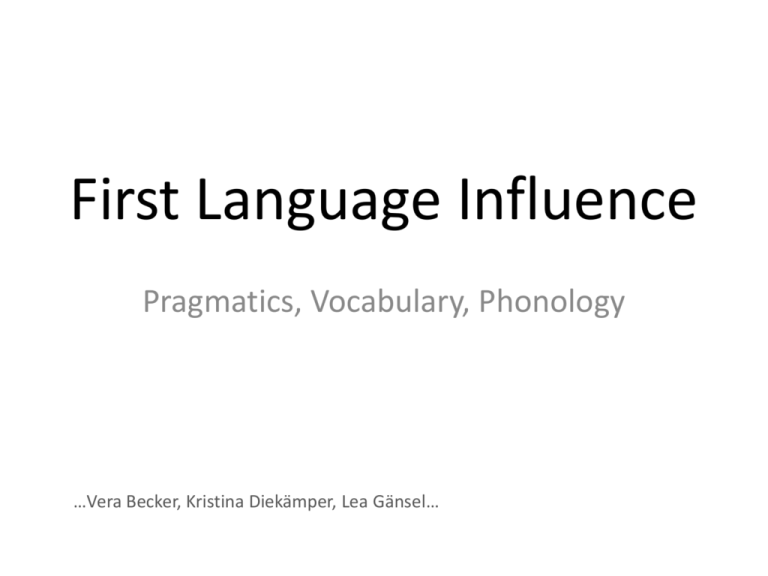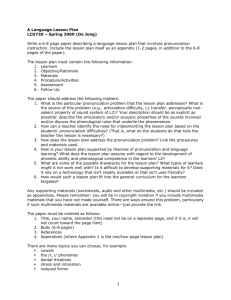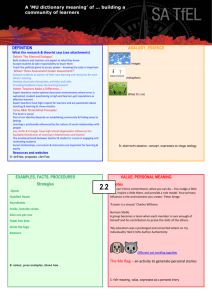First Language Influence
advertisement

First Language Influence Pragmatics, Vocabulary, Phonology …Vera Becker, Kristina Diekämper, Lea Gänsel… Pragmatics Definition: “The study of how words and phrases are used with special meaning in certain situations” Longman Dictionary of Contemporary English (2003) Pragmatics • politeness • request • apologies → Same words can mean something totally different in a different setting. Pragmatics Examples: • • • • Have a good day and say „hi“ to your friends! Are there any more questions in the back? What a nice dress! Is that your dog? Pragmatics Difficulties: Learners progress their pragmatic knowledge but problems with specific cultural aspects remain and the language levels do not significantly correlate with pragmatic knowledge. Pragmatics Knowledge: 1. The pragmatic knowledge necessary to cope with a foreign language is available to all learners from the start. 2. Some things are universal (international structures of speech). 3. Some can be transferred from the L1 (could, would, as elements of politeness). Pragmatics Classroom differences to non- instrumental environments: 1. a more narrow range of speech acts 2. a lack of politeness marking 3. monopolization of discourse organization and management by the teacher Kasper (1997) Pragmatics Classroom strategies: • observation tasks • use of authentical material • students observe a certain pragmatic aspect outside the classroom Pragmatics • Learners are NOT native speakers, demanding perfect pragmatic understanding would be clearly over ambitious • Native speakers might even expect nonnatives to act as non- native speakers on the pragmatic level. Pragmatics Classroom advantages for studying pragmatics: 1. opportunities to reflect on the L2 knowledge 2. opportunities to „try out“ the new pragmatic knowledge 3. L2 teacher can offer support in the classroom Peirce(1995) Importance of Vocabulary • We can communicate by using words that are not placed in the proper order, pronounced perfectly, or marked with the proper grammatical morphemes. BUT: Communication breaks down if we do not use the correct word! English Vocabulary • English has anywhere from 100.000 to 1.000.000 words. • An educated adult speaker of English knows at least 20.000 words. • Most everyday conversation requires about 2.000 words. Vocabulary Acquisition • Acquiring a basic vocabulary is a significant accomplishment for L2 learners. BUT: → L2 learners are exposed to far smaller samples of the language to be learned than L1 learners! → The contexts in which L2 learners encounter new vocabulary may not be as helpful! Access to Vocabulary Acquisition • The first step in knowing a word is to recognize that it is a word (Meara, 2005): frolip – laggy – scrule – albeit → only albeit is an English word gonion – micelle – lairage – throstle → all are English words Factors for Vocabulary Acquisition • The frequency with which a word is seen, heard and understood is important to make new vocabulary more easily learnable by L2 learners (Nation, 2001). → about 16 times and even more to retrieve the word in fluent speech! Factors for Vocabulary Acquisition List 1 List 2 List 3 Friend Hamburger Government More Coke Responsibility Town T-Shirt Dictionary Book Walkman Elementary Hunt Taxi Remarkable Sing Pizza Description Box Hotel Expression Smile Dollar International Eye Internet Preparation Night Disco Activity → Which list would you expect to be learned most easily by beginning L2 learners? Factors for Vocabulary Acquisition • The presence of cognates and borrowed words makes words more accessible to L2 learners. BUT: There can occur difficulties with words that look similar but have different meanings! Learning Vocabulary • Reading for pleasure is the best source of vocabulary growth (Krashen, 1985/1989). BUT: You need to know at least 95% of the words in a text to infer the meaning of a new word (Laufer, 1992)! Learning Vocabulary • Vocabulary development is more successful when learners are fully engaged in activities that require them to attend carefully to the new words and even to use them in productive tasks (Hulstjin and Laufer, 2001). Learning Vocabulary • Effort and strategies like keeping a notebook, looking up words in a dictionary, and reviewing what has been learned are associated with better vocabulary development (Kojic-Sabo and Lightbown, 1999). Phonology • Grammar has been the focus for second language teachers and researchers for a long time. • Pronunciation was the central component during the audiolingual era. several teaching techniques were developed Audiolingual era • Focus on getting learners perceiving and producing distinctions between single sounds. minimal pair drills Audiolingual era • Audiolingualism & behaviourism were replaced by other views of learning. native-like pronunciation was an unrealistic goal and the instruction time was better spent on teaching features that learners might learn more easily. Grammar Communicative language teaching • 1970‘s : Communicative language teaching was introduced. • Less attention to pronunciation emphasis was on rhythm, stress, intonation considered more likely to affect communication Phonological development • Aspects of 1st language acquisition have influence on 2nd language learners’ phonological development. • Example: Japanese & Korean problems to hear and produce l and r these sounds do not occur in their language. Phonological development • Example: few languages have the th sounds that are frequent in English. Learners may substitute similar sounds from their 1st language ( t or d, s or z ). . Learners may overcompensate = Learners pronounce a th where a t belongs. Phonological development • Such errors are similar to the overgeneralization errors. • If they replace earlier ‘correct’ pronunciation of t or d sounds represent progress in learners ability to notice and to produce the th sound. Phonological development • Big differences between 1st language and 2nd language can lead to great difficulties. It takes learners longer to reach a high level of fluency in a particular 2nd or foreign language. • Language distance affects pronunciation as well. Phonological development • Theo Bongaerts ( 1999) collected speech samples of… …highly proficient speakers who had learned Dutch in their adulthood. …who came from a wide variety of 1st language backgrounds. Phonological development • Native speakers of Dutch were asked to judge these samples. Learners who spoke a language which was closely related to Dutch were judged to have a native-like accent ( German, English). Learners who spoke a language which was more distant from Dutch were judged to have no native-like pronunciation (Chinese). Phonological development • Influential contributors to pronunciation are: differences / similarities between 1st language and 2nd language. the amount and type of exposure to the target language. (that longer periods of exposure to the 2nd language can lead to improve pronunciation.) the degree of use of the 1st language. (greater use of 1st language stronger accent) Segmental vs. Suprasegmental • It can make a difference if the instructor focuses on suprasegmental rather than on segmental aspects of pronunciation. • Tracey Derwing and her colleagues (1998,2003) carried out a series of studies on how intelligible learners were judged to be. Segmental vs. Suprasegmental • Learners who received pronunciation lessons emphasizing stress an rhythm were judged to be easier to understand than learners who received lessons focused on individual sound. more accurate in their use of sounds did not increase listeners’ perception of the intelligibility of their speech to others What is the Standard ? • Intelligibility rather than native-like ability is the standard learners should strive toward. • The presence of a strong foreign accent does not necessarily result in reduced intelligibility or comprehensibility. ( Tracey Derwing) What is the Standard ? • People increasingly interact with speakers who have learned a different variety of the same language. Nevertheless, a different accent still serves as a marker of group membership/ discrimination. Pronunciation • To have a native-like accent is irrelevant to most of the learners and not a goal they need to reach. • Nevertheless, a combination of instruction, exposure, experience and motivation should be required. • Achieving native or near-native pronunciation ability is an accomplishment not experienced by most second language learners. Questions • Why is it necessary to learn the use of pragmatics? • What are the difficulties for L2 learners referring to pragmatics? • Which factors make new vocabulary more accessible to L2 learners? • What is more effective, receiving lessons on segmental or suprasegmental phonology? Why? • What are the influential contributors to pronunciation?







